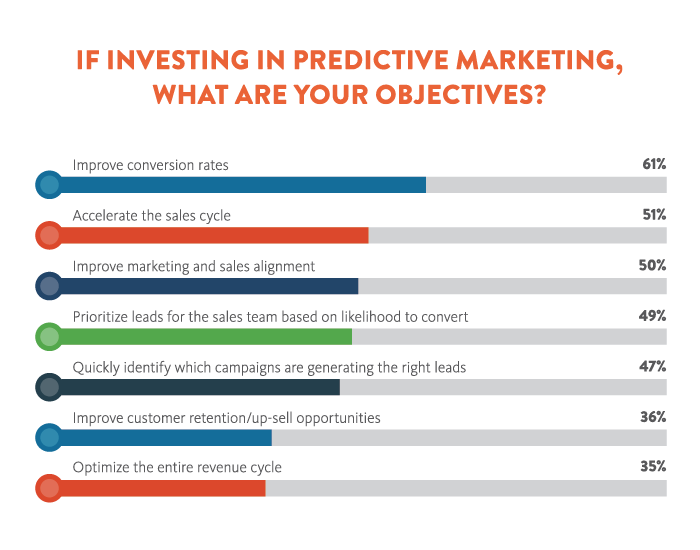B2B marketers are beginning to recognize the power and benefits of predictive marketing analytics and are investing heavily to get up to speed this year. They still have a long road ahead, but early wins by progressive marketers are garnering major attention and spurring demand. Vendors in the space, meanwhile, are registering explosive growth to meet demand.
Forrester Research found that nearly two-thirds (64%) of marketers are implementing or upgrading predictive analytics solutions today or plan to do so in the next 12 months in a report published in July, titled New Technologies Emerge To Help Unearth Buyer Insight From Mountains Of B2B Data.
“There’s a lot of potential in predictive technologies to help marketers engage with prospects and engage with existing customers,” said Laura Ramos, VP and Principal Analyst at Forrester.
Ramos said predictive marketing analytics can help B2B marketers determine when to engage buyers, how to effectively execute cross channel campaigns and where to allocate budget.
A recent study conducted by Demand Gen Report sees similar numbers in its own research. The report shows that sponsored by Lattice Engines, 58% of B2B marketers are either currently use predictive tools or plan to within the next six to 12 months.
“The holy grail of marketing has always been the right message in the right channel at the right time,” said Nipul Chokshi, Head of Product Marketing at Lattice Engines. “Predictive is the piece that gets you there.”
Recent growth and investment strengthens this claim. In the past 60 days, there have been a handful of major cash infusions flowing into predictive analytics providers’ coffers:
- Radius announced that it scored $50 million in funding that the marketing software company intends to use to scale its predictive marketing platform to meet demand. Radius said in its announcement that its revenue increased by more than 400% in the past year and it has doubled its employee base.
- Leadspace announced its own infusion of $18 million cash a week after Radius, and the company said earlier this year that it doubled its customer base.
- 6sense, which raised $20 million in funding in February 2015, received an additional investment from Salesforce Ventures in July that CEO Amanda Kahlow characterized as “significant,” though she would not share exact figures. Kahlow said the investment would enable deeper integration of 6sense’s predictive solution into Salesforce products. 6sense has more than doubled its employee base in 2015, and Q2 revenues this year were four times higher than the first quarter.
- Lattice Engines raised $28 million in a financing round in June.
B2B Buyers Testing Multiple Predictive Tools
Many of the B2B marketers who are currently experimenting with predictive analytics are using multiple vendors and programs inside their organizations.
“They’re using them to solve problems or doing an internal bake-off to see what works better,” Ramos said, though she acknowledged that gets harder to do in enterprise-level organizations.
Despite the power of predictive analytics tools to lasso Big Data and democratize the process to an extent that even those who are not data scientists can benefit from it, the majority of B2B marketers are still sitting on the sidelines.
“Most B2B marketers aren’t ready to put the full power of predictive analytics into play.” Ramos said. She said in her experience most B2B marketers have yet to drive results beyond advanced lead scoring.
Ramos noted that most B2B marketers have yet to drive results beyond advanced lead scoring. “This view is shortsighted,” Ramos said. “The real value of predictive marketing occurs when you apply this approach across the customer lifecycle.”
Optimizing the entire revenue cycle came was not a priority for B2B marketers polled in the Demand Gen Report study. Even for those already investing in predictive, the focus remains primarily on achieving top-of-the-funnel goals.

Source: “The Full Funnel Effect: How Predictive Drives Value At Every Stage Of The Revenue Cycle,” Demand Gen Report
However, examples of early wins by using predictive abound. According to Lattice Engines, DocuSign used predictive marketing to prioritize leads and run them through a nurturing program. The result was a 38% win rate, Chokshi said. Another client, a financial payments processor, saw a 20% call-to-win rate using predictive. And client VMWare, which used predictive to identify cross-selling opportunities, tripled their win rate.
Kahlow at 6sense said a customer ran a test with 2,000 records, comparing their in-house analysis with 6sense’s predictive technology. Five of the control group prospects converted; 299 of the prospects 6sense analyzed converted. “We’re able to find real results [for our customers],” she said.
For marketers to fully harness the wealth of information available, basic processes and thinking also needs to change, experts noted.
“It’s a challenging process,” said David Lewis, CEO of DemandGen International.
Lewis said marketers need to “be careful of the shiny new toy syndrome. Predictive will not solve lead gen,” Lewis said. “That’s going to come down to the people involved and their skill set, and the ability to bring together disparate systems and technology. They also need to master existing technology such as marketing automation and CRM systems.”
“You can have the best lead scoring system and algorithm in the world, but if your sales force is not trained in and using the CRM, it’s a wasted effort,” Lewis noted.
Ramos put it this way: “[B2B marketers] are not thinking holistically about the customer lifecycle to anticipate outcomes. It’s not as easy to make it work as it is to get into it.” She compared it to the early days of marketing automation, in which marketers wanted the technology to be the easy answer.
Therein lies perhaps the biggest challenge, which is changing processes entirely to accommodate the power of predictive marketing.
“These are thoughts and questions that sales and marketing people haven’t had with each other,” Lewis said.
6sense’s Kahlow said that predictive “should act as the central nervous system powering all sales and marketing.”
Ramos also noted that the biggest business impact will happen when marketers learn how to use predictive analytics to simultaneously target markets efficiently, streamline pipeline conversion, retain customers, grow customer lifetime value and turn loyal customers into advocates. In order to do so, Forrester’s Ramos recommends four key preparatory steps for marketers in order “to take the predictive analytics plunge:”
Model ideal account and lead opportunities. To kick off predictive marketing analytics correctly, B2B marketers should sit down with sales, support and service delivery to talk about how ideal customers differ based on their key characteristics (fit), the way they look for solutions (intent), and their interest in what you offer (interest).
Anticipate what success looks like. To use advanced analytics well, you don’t need to start with a hypothesis, but you do need to have an objective to inductively format the question — such as “Which customer is most likely to respond to this offer?” — and let the models and algorithms uncover the patterns in the data that answer the question. Starting with overall company objectives, B2B marketers should look beyond lead scoring to prioritize the list of business questions to tackle with new data analytic approaches.
Work with technology management to size architectural requirements. B2B marketers can’t build advanced analytic systems alone. Developing the business discipline and technology needed to harness insights and consistently turn customer data into action requires close collaboration with your technology management counterparts. Marketing’s job is to define where and how to embed insights discovery in visualization tools or marketing applications — for example, to help industry, product or content marketing managers determine which message or campaign element will connect better with which audience to drive interest, preference and purchase.
Use insight to create more valuable sales conversations. Customers expect salespeople to be experts on their businesses and the market conditions in which they operate. Having insight into account specific issues, and empathy for buyers’ challenges, makes sales conversations more business relevant and welcome. To get there, focus your initial analytics endeavors on helping sales not only pursue the most promising opportunities, but also apply this deeper understanding of their unique client needs to what your brand can promise.







